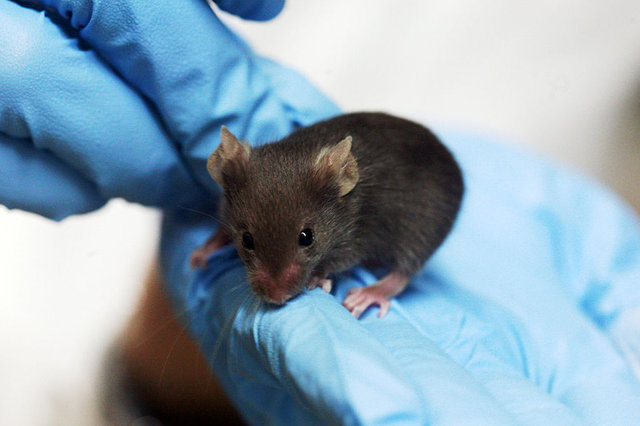Old drugs can sometimes yield surprising results. A well-known diabetes pill called Metformin, for instance, is now being used to
treat certain cancers. And
Thalidomide, a drug used as a sedative in the ’50s, is now used to treat leprosy and bone marrow cancer. But a
new study published today in
Translational Psychiatry might beat these examples, as it reveals that suramin, a drug that was developed in 1916 to treat African sleeping sickness, can restore normal social behaviors in adult mouse models of autism. These results won't lead to new autism therapies right away — suramin has not been tested on humans with autism, and it's actually toxic if dispensed for longer than a few months — they do hint at the new directions that researchers might explore.
THE MICE BECAME MORE SOCIAL AFTER A SINGLE DOSE
In the study, researchers administered a dose of suramin to 25 male mice, whereas another 25 males received a saline injection instead. All mice were "maternal immune activation mouse models," meaning animals that exhibit autism-like behaviors following a virus infection in their mothers during pregnancy. This single dose, the researchers report, corrected the social behaviors seen in autism spectrum disorder. The mice, for instance, spent more time interacting with both mice and objects they had never interacted with before, compared to those injected with a saline solution. The benefits lasted for five weeks after the drug was washed out of their system.
The scientists think suramin acts by binding to, and inhibiting, 19 different receptors — called "purinergic" receptors — that are expressed on every cell type in the body. This binding action prevents ATP, our body's energetic currency unit, from binding to these specific receptors, which then helps turn off a cellular response known as the "
cell danger response."
THE CELL DANGER RESPONSE CAN CHANGE THE TRAJECTORY OF NEURODEVELOPMENT
"The cell danger response is an evolutionarily conserved set of about 30 metabolic changes that help protect cells from threat," explained Robert Naviaux, a geneticist at the University of California San Diego and lead author of the study, in an email to The Verge. These metabolic changes can be beneficial, because they allow the re-allocation of energetic resources in times of stress, like when the body encounters viruses, pollutants, or even certain drugs. But "when significant exposures happen during pregnancy or in early childhood," Naviaux said, "the trajectory of neurodevelopment can be changed." Moreover, "cells retain a metabolic memory of these significant exposures according to the severity of the stress and the developmental timing of the exposure."
So, if the change in resource allocation is severe enough, it may also alter normal cellular functions that are required for healthy neurodevelopment. And suramin's binding action seems to reverse this change in function by allowing cells to return to their normal metabolism, Naviaux said — "and their normal jobs."
SURAMIN IS TOXIC IN THE LONG-RUN
Unfortunately, suramin can't be administered for longer than a few months because of long-term toxicity. Naviaux thinks people shouldn't focus on that aspect of the study, however, because scientist may one day find less damaging drugs that have similar effects. These therapies could be given "only once or intermittently," he says, to unblock metabolism and restore more normal social behaviors.
"This really takes a novel approach to understanding what's going on in autism," says Richard Frye, director of autism research at the University of Arkansas who did not participate in the study. "I think the argument that, when a cell senses danger, it changes its metabolism to protect itself makes a lot of sense — and it makes a lot of sense with what we see in autism."
"IT MAKES A LOT OF SENSE WITH WHAT WE SEE IN AUTISM."
But other researchers are less enthusiastic. "[The findings] are valuable, but the main problem is that they rely on a model of immune infection, not a genuine model of autism," said Yehezkel Ben-Ari, an autism researcher at the Mediterranean Institute of Neurobiology who was not involved in the study, in an email to The Verge. "They should have tested one of the classical models of autism," he said — meaning genetic models of autism — to see whether suramin indeed corrects autistic behaviors.
Naviaux has heard such criticisms before, and argues that the model is appropriate given that serious viral infections and fevers during human pregnancy can increase the risk of autism and other neurodevelopmental disorders in children. In addition, he said, the mouse model "actually produces more severe symptoms" than many of the conventional autism animal models. "No animal model is a perfect match for complex human diseases like autism or schizophrenia," Naviaux said, but this is "one of the best."
There are other possible limitations to this work. For example, this mouse model doesn't reproduce all behaviors linked to autism, such as repetitive behaviors. The study also involved a small number of mice, and the researchers only tested suramin
on males.
"GENES INTERACT WITH ENVIRONMENTAL FACTORS."
It should also be noted that Naviaux's explanation for behavioral symptoms seen in people with autism spectrum disorder doesn't contradict current notions regarding its genetics. "It is very clear that genes interact with environmental factors to cause autism," Naviaux said. But "even in the rare cases of single genes that can increase the risk of autism spectrum disorders, no single-gene disorder produces [autism] in 100 percent of the children who have the gene."
The idea that autism might be the result of abnormal cell communication is still fairly new. But Naviaux thinks exploring the cell danger response theory is important. "According to the theory, abnormal cell metabolism can result from genes, environment, or both," he said. So, the key to treatment may lie in finding the way to restore normal cell metabolism, and more normal development as a result. "Some things that we thought were a permanent feature of the mouse models, are actually treatable with the right metabolic intervention," Naviaux said, which means that "despite the permanent loss of certain brain cell connections in the mouse models of autism ... social and exploratory behaviors can be improved with the right treatment."

